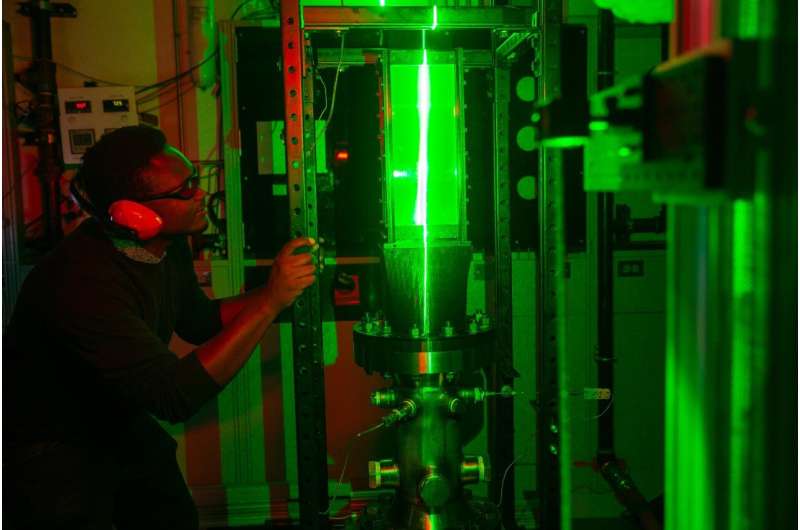
To measure the flow of air through a jet engine, researchers traditionally place sensors where air enters and exits.
But the turbulence within the engine remains a bit of a mystery, University of Cincinnati doctoral candidate Vincent Onoja said. He wants to know what's going on inside the engine, specifically the custom nozzle that determines so much of an aircraft's performance, noise and efficiency.
"Typically, they measure at the entrance of the chamber or the exit of the chamber, but it's more difficult to measure the airflow inside the nozzle," he said.
Computer simulations are only so accurate. And putting anything, even the smallest sensors, inside the nozzle chamber might interfere with its airflow dynamics, he said. Onoja is studying aerospace engineering in UC's College of Engineering and Applied Science.
Onoja and UC Assistant Professor Daniel Cuppoletti came up with a new experimental protocol that uses high-speed cameras and laser diagnostics to track airflow within the engine.
"We designed an experiment where we would have a window where you shoot a laser inside and we can observe airflow using high-speed cameras," he said.
They use a technique called particle image velocimetry. Researchers inject an aerosol into the engine and capture the individual particles as they travel using a laser and a camera that can record up to a million frames or images per second. By comparison, sports photography cameras record just 120 images per second.
Even incremental improvements to engines can save millions of dollars in fuel and productivity in commercial aviation or drastically improve the performance of aircraft. Likewise, understanding how turbulence affects engine noise can help engineers design quieter aircraft. So understanding the properties of airflow is a very big deal for aerospace engineers.
The project is a collaboration between UC, the Massachusetts Institute of Technology and the U.S. Office of Naval Research.
UC has a long history of working with aviation partners both locally and around the world, Cuppoletti said.
"Historically, we have had a lot of excellent collaborations in aircraft propulsion and gas turbine technology with Cincinnati's General Electric and the U.S. Air Force Research Lab at Wright-Patterson," he said. Cuppoletti worked on aircraft propulsion systems at Northrop Grumman before coming to UC.
Doctoral student Onoja is from Nigeria, where he studied mechanical engineering. He was inspired to follow in the footsteps of his uncle, a retired aerospace engineer who worked on NASA's space shuttle program at Boeing Corp.
"Any time he would visit, he would show me pictures of the space shuttle and that's what sparked my interest in aerospace engineering," Onoja said.
Onoja hopes to contribute to NASA's 10-year New Aviation Horizons Initiative dedicated to spurring transformative technology.
"They're working on the next generation of improved efficiency and performance for aircraft," Onoja said. "I'm studying new jet engine nozzle designs that would meet NASA's goals for improving performance while reducing noise and emissions."
Onoja capitalized on his experience in advanced measurement techniques to land an internship at Tesla, where he worked with a team to design new experimental protocols for studying vibration in the automaker's Cybertruck.
While professor Cuppoletti's project is just getting started, Onoja said he is optimistic that their methods will provide new insights in airflow dynamics, which could have profound benefits for aviation.
"The key goal is advancing our ability to accurately predict airflows in complex systems," Onoja said. "We can use high-fidelity experimental data to improve and validate our computational models."
Their new system and its related computer models can be used to study airflow in virtually any engine, he said.
"My work will serve as a basis for comparison," Onoja said. "And then we can put that knowledge to work. Aerospace companies like Boeing or GE can take that knowledge and apply it to their own research and design."
Citation: Project sheds light on turbulence within jet engines (2024, July 30) retrieved 30 July 2024 from https://techxplore.com/news/2024-07-turbulence-jet.html
This document is subject to copyright. Apart from any fair dealing for the purpose of private study or research, no part may be reproduced without the written permission. The content is provided for information purposes only.
